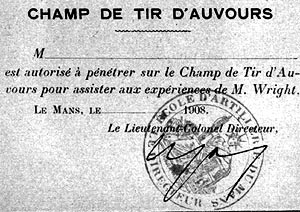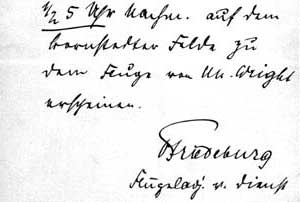| Ticket for Admittance to Champ de Tir d'Auvours, 1908 |
 [Ticket, 1908].
Subject File: Foreign Business--Countries
--France--Negotiations with Government, 1908-1910. Wilbur
and Orville Wright, Manuscript Division, Library of Congress.
[Ticket, 1908].
Subject File: Foreign Business--Countries
--France--Negotiations with Government, 1908-1910. Wilbur
and Orville Wright, Manuscript Division, Library of Congress.
|
As Orville was about to make his successful demonstration flights for the U.S. Army at Fort Meyer,
Virginia, Wilbur was in France showing Europe and the world to what degree he and his brother had mastered
the problem of flight. For four months beginning in August, Wilbur flew at the large artillery field
seven miles east of Le Mans known as Camp d'Auvours. Having made nine successful flights two weeks earlier
at a race course called Les Hunaudieres, five miles south of Le Mans, Wilbur became an overnight sensation
in France. Large crowds eager to witness his effortless mastery of the air necessitated the introduction
of a ticket system to control access. Only holders of tickets signed by the local military commander
and Hart O. Berg, the Wrights' business agent, were permitted to enter the grounds.
|
| Postcard, Wilbur Wright to Orville Wright, September 1908 |
 [Postcard, Wilbur Wright to Orville Wright, September 1908].
Family Papers: Correspondence--Wright, Wilbur,
September 1908. Wilbur and Orville Wright,
Manuscript Division, Library of Congress.
[Postcard, Wilbur Wright to Orville Wright, September 1908].
Family Papers: Correspondence--Wright, Wilbur,
September 1908. Wilbur and Orville Wright,
Manuscript Division, Library of Congress.
|
Before his September 17 crash during the U.S. Army acceptance trials at Fort Meyer, Virginia, nearly
every flight that Orville attempted broke the flight duration record that he had set on the previous
flight. His longest flight lasted one hour, fourteen minutes, and twenty seconds, during which he made
seventy-one circles around the field at an altitude of about three hundred feet. Wilbur, flying in France
at the time, used this postcard drawn by the French artist, Leo Maix, to show Orville how proud he was
of his younger brother's accomplishments. Wilbur wrote: "I'll tie a string to you next time to keep
you from going too high or too far. It's too much trouble to break your records. Will." Postcards such
as these showing Wilbur dressed in his customary flying cap and leather jacket became popular during
1908 and 1909.
|
| Letter, Orville Wright to Wilbur Wright, November 14, 1908 |
 [Letter, Orville Wright to Wilbur Wright,
14 November 1908].
Family Papers: Correspondence
--Wright, Orville, September to December 1908.
Wilbur and Orville Wright Papers, Manuscript Division,
Library of Congress.
[Letter, Orville Wright to Wilbur Wright,
14 November 1908].
Family Papers: Correspondence
--Wright, Orville, September to December 1908.
Wilbur and Orville Wright Papers, Manuscript Division,
Library of Congress.
|
Following his near-fatal crash at Fort Meyer, Orville spent seven weeks in the hospital and wrote
his first letter to Wilbur, who was in France. Orville spends little time talking about his own injury,
but rather provides as much detail as he can about the disastrous flight. He tells Wilbur that during
the fourth turn around the field, he "heard (or felt) a light tapping in the rear of the machine." Realizing
that something had broken, he shut off the power but soon found the machine shaking terribly and the
controls useless. Flying at least one hundred feet up, the machine headed straight for the ground, and
Orville recalled that, "the first 50 ft of that plunge seemed like a half minute." Although it nearly
righted itself, the machine crashed, breaking Orville's leg and ribs, injuring his back, and killing
his passenger, Lt. Thomas E. Selfridge. Later tests proved that Orville was correct when he wrote Wilbur
that a broken propeller was probably the cause.
|
| Written Communication from Adjutant Friedeburg to Orville Wright, October 15, 1909 |
 [Letter, Adjutant Friedeburg to Orville Wright,
15 October 1909]. General Correspondence: Wilhelm II,
German Emperor, 1909. Wilbur and Orville Wright Papers,
Manuscript Division, Library of Congress.
[Letter, Adjutant Friedeburg to Orville Wright,
15 October 1909]. General Correspondence: Wilhelm II,
German Emperor, 1909. Wilbur and Orville Wright Papers,
Manuscript Division, Library of Congress.
|
In 1909 the Wrights flew in France, Italy, and Germany, and many of the greats and near-greats of
Europe came to witness this spectacle. This note, sent to Orville by Friedeburg, the imperial aide to
German Emperor Wilhelm II, informed him that "the Kaiser will appear at the Bornstedt airfield at 4:
30 PM for Mr. Wright's flight." This was Orville's last flight in Germany, as he delayed his departure
from Berlin because of the emperor's request. Orville's farewell flight lasted twenty-five minutes,
during which time he greatly impressed everyone with his machine's maneuverability and tight turns.
Among the royal personalities to see the Wrights fly in 1909 were King Alfonso XIII of Spain, King Edward
VII of England, King Victor Emmanuel III of Italy, and Crown Prince Friedrich Wilhelm of Germany.
|


 [Ticket, 1908].
Subject File: Foreign Business--Countries
--France--Negotiations with Government, 1908-1910. Wilbur
and Orville Wright, Manuscript Division, Library of Congress.
[Ticket, 1908].
Subject File: Foreign Business--Countries
--France--Negotiations with Government, 1908-1910. Wilbur
and Orville Wright, Manuscript Division, Library of Congress.
 [Postcard, Wilbur Wright to Orville Wright, September 1908].
Family Papers: Correspondence--Wright, Wilbur,
September 1908. Wilbur and Orville Wright,
Manuscript Division, Library of Congress.
[Postcard, Wilbur Wright to Orville Wright, September 1908].
Family Papers: Correspondence--Wright, Wilbur,
September 1908. Wilbur and Orville Wright,
Manuscript Division, Library of Congress.
 [Letter, Orville Wright to Wilbur Wright,
14 November 1908].
Family Papers: Correspondence
--Wright, Orville, September to December 1908.
Wilbur and Orville Wright Papers, Manuscript Division,
Library of Congress.
[Letter, Orville Wright to Wilbur Wright,
14 November 1908].
Family Papers: Correspondence
--Wright, Orville, September to December 1908.
Wilbur and Orville Wright Papers, Manuscript Division,
Library of Congress.
 [Letter, Adjutant Friedeburg to Orville Wright,
15 October 1909]. General Correspondence: Wilhelm II,
German Emperor, 1909. Wilbur and Orville Wright Papers,
Manuscript Division, Library of Congress.
[Letter, Adjutant Friedeburg to Orville Wright,
15 October 1909]. General Correspondence: Wilhelm II,
German Emperor, 1909. Wilbur and Orville Wright Papers,
Manuscript Division, Library of Congress.